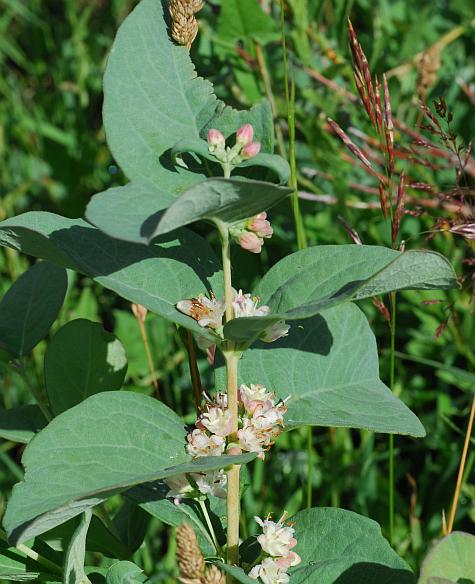Symphoricarpos occidentalis Hook.
Wolfberry, Western Snowberry

Native
CC = 10
CW = 5
MOC = 2
SRank = S1
© SRTurner
Symphoricarpos occidentalis Hook.Wolfberry, Western Snowberry | |
 |
Native CC = 10 CW = 5 MOC = 2 SRank = S1 |
© SRTurner |
|
Family - Caprifoliaceae Habit - Shrub to 1.0 m. Stems - Young twigs short-hairy, later becoming glabrous. Bark gray to grayish brown, thin, tending to become shredded.
Leaves - Opposite, simple, entire, petiolate. Petioles 3-7 mm long. Leaf blades 2-4 cm long, 12-25 mm wide, oblong-elliptic to broadly ovate, broadly rounded or broadly angled to nearly truncate at the base, rounded or angled to a bluntly pointed tip (those of the lobed first leaves of the season sometimes appearing sharply pointed), the upper surface bright green to dark green, the undersurface pale green, short-hairy, at least along the veins, usually not glaucous.
Inflorescences - Dense axillary clusters of sessile flowers.
Flowers - Corollas 5-9 mm long, lobed about 1/2 of the way to the base, pale pink or occasionally greenish white. Stamens with the anthers 1.8-2.2 mm long, exserted from the corolla. Styles glabrous.
Fruits - Berrylike drupes 5-9 mm in diameter, white or greenish white. Nutlets 3.0-3.5 mm long, elliptic in outline, rounded to bluntly pointed at each end.
Flowering - June - August. Habitat - Mesic upland forests and margins of loess hill prairies. Origin - Native to the U.S. Lookalikes - None. Other info. - This species is rare in Missouri, currently reported from only two counties in the extreme northwest corner of the state. In fact, Missouri's populations occur at the very edge of the plant's natural range, which is mainly found within the upper Plains states. The plant is identified by its opposite, broadly elliptic leaves and axial flowers. Photographs taken at Rocky Mountain National Park, Larimer County, CO, 8-2-2017, and near Three Forks, Gallatin County, MT, 8-14-2019 and 6-17-2021 (SRTurner). |